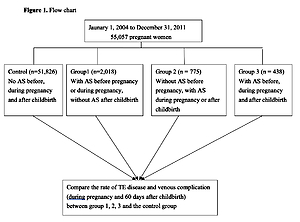Current issue
Archive
Manuscripts accepted
About the Journal
Editorial office
Editorial board
Section Editors
Abstracting and indexing
Subscription
Contact
Ethical standards and procedures
Most read articles
Instructions for authors
Article Processing Charge (APC)
Regulations of paying article processing charge (APC)
PULMONOLOGY / RESEARCH PAPER
Asthma is a risk factor for thromboembolic disease in pregnancy
1
Chung Shan Medical University Hospital, Taiwan
2
School of Medicine, Chung Shan Medical University, Taiwan
3
Department of Emergency Medicine, Changhua Christian Hospital, Changhua, Taiwan, Taiwan
4
Chung Shan Medical University, Taiwan
5
Department of OBS/GYN, Jin-Sin Women and Children’s Hospital, Taiwan
Submission date: 2021-11-11
Final revision date: 2021-12-30
Acceptance date: 2022-01-28
Online publication date: 2022-02-18
KEYWORDS
TOPICS
ABSTRACT
Introduction:
Finding the risk factors for thromboembolic (TE) disease and preventing its development in pregnant women is important. Asthma is a common chronic disease in pregnant women. The aim of the study is to find the risk factors.
Material and methods:
From 2004 to 2011, 55,057 pregnant women were recruited from a Taiwan database. They were grouped into AS and non-AS groups. AS subjects were divided into three groups. Group 1: with AS before pregnancy or during pregnancy; without AS after childbirth. Group 2: without AS before pregnancy, with AS during pregnancy or after childbirth. Group 3: with AS before, during pregnancy and after childbirth. The rate of TE (during pregnancy and 60 days after childbirth) was compared between different groups.
Results:
In pregnant women, TE rate was 2.47‰ in AS and 0.71‰ in non-AS subjects. The rate was higher in AS subjects (OR 3.47, adjust p 0.005). In group 2, the rate was 3.97‰, higher than that in non-AS subjects (OR 5.44, p 0.013). The TE rate in groups 1 and 3 was similar to non-AS subjects.
Conclusions:
The rate of TE increases if pregnant women have AS. Physicians need to be alert to the occurrence of TE as early as possible in pregnant women with AS. If AS was re-appeared or worsened during pregnancy (group 2), the rate of TE increased. Pregnant women and physicians should prevent the re-appear of AS or control AS properly during pregnancy to prevent the occurrence of TE.
Finding the risk factors for thromboembolic (TE) disease and preventing its development in pregnant women is important. Asthma is a common chronic disease in pregnant women. The aim of the study is to find the risk factors.
Material and methods:
From 2004 to 2011, 55,057 pregnant women were recruited from a Taiwan database. They were grouped into AS and non-AS groups. AS subjects were divided into three groups. Group 1: with AS before pregnancy or during pregnancy; without AS after childbirth. Group 2: without AS before pregnancy, with AS during pregnancy or after childbirth. Group 3: with AS before, during pregnancy and after childbirth. The rate of TE (during pregnancy and 60 days after childbirth) was compared between different groups.
Results:
In pregnant women, TE rate was 2.47‰ in AS and 0.71‰ in non-AS subjects. The rate was higher in AS subjects (OR 3.47, adjust p 0.005). In group 2, the rate was 3.97‰, higher than that in non-AS subjects (OR 5.44, p 0.013). The TE rate in groups 1 and 3 was similar to non-AS subjects.
Conclusions:
The rate of TE increases if pregnant women have AS. Physicians need to be alert to the occurrence of TE as early as possible in pregnant women with AS. If AS was re-appeared or worsened during pregnancy (group 2), the rate of TE increased. Pregnant women and physicians should prevent the re-appear of AS or control AS properly during pregnancy to prevent the occurrence of TE.
Share
RELATED ARTICLE
We process personal data collected when visiting the website. The function of obtaining information about users and their behavior is carried out by voluntarily entered information in forms and saving cookies in end devices. Data, including cookies, are used to provide services, improve the user experience and to analyze the traffic in accordance with the Privacy policy. Data are also collected and processed by Google Analytics tool (more).
You can change cookies settings in your browser. Restricted use of cookies in the browser configuration may affect some functionalities of the website.
You can change cookies settings in your browser. Restricted use of cookies in the browser configuration may affect some functionalities of the website.



